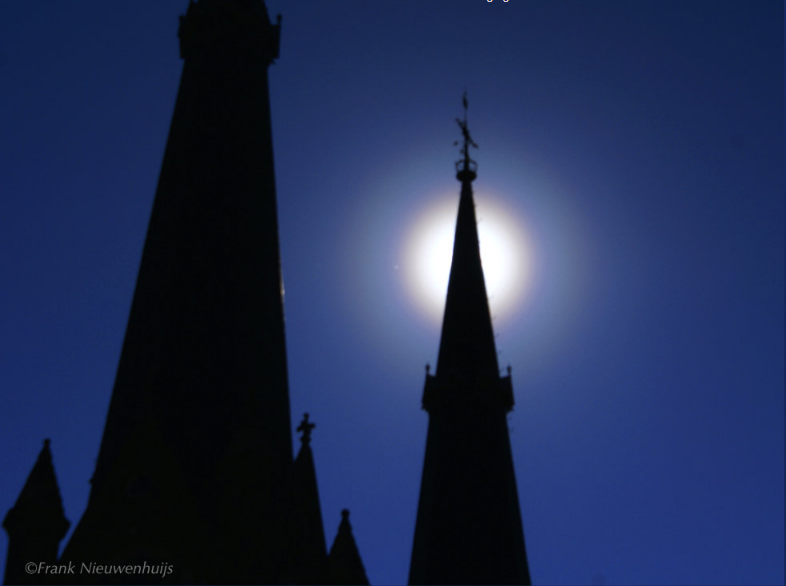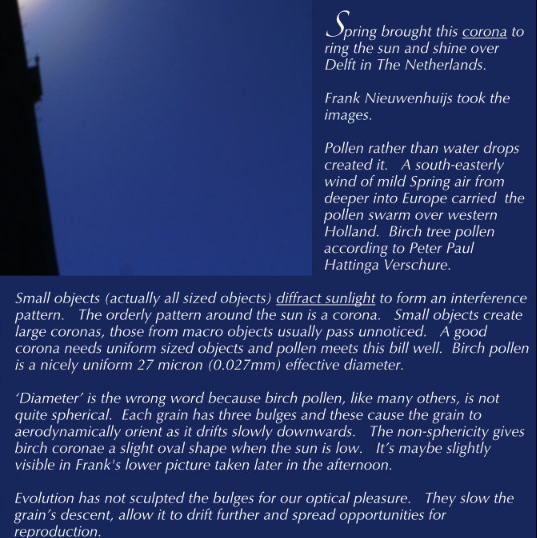Pollen Corona over Delft
Pollen Corona over Delft: A Spectacular Spring Phenomenon
The city of Delft in The Netherlands was treated to a mesmerizing display of nature's artistry during the spring season. Captured by photographer Frank Nieuwenhuijs, the images showcased a stunning corona encircling the sun. However, unlike the typical coronas formed by water droplets, this particular phenomenon was created by pollen particles suspended in the air. Let's delve into the fascinating world of atmospheric optics and explore the science behind this captivating pollen corona over Delft.
The Role of Pollen in Corona Formation
Coronas are formed when sunlight interacts with small objects, causing diffraction and interference patterns. These patterns give rise to the distinctive circular rings observed around the sun. While macro objects often go unnoticed, smaller objects like pollen grains can create larger and more noticeable coronas. The key to a well-defined corona lies in the uniformity of the object's size, which is precisely met by pollen particles.
The Unique Characteristics of Birch Pollen
In the case of the pollen corona over Delft, it was primarily composed of birch tree pollen. Birch pollen grains have an effective diameter of approximately 27 microns (0.027mm). Although they are not perfectly spherical, each grain possesses three bulges that influence its aerodynamic behavior as it descends through the air. This non-sphericity results in a slight oval shape of the birch corona, especially when the sun is low on the horizon.
The Purpose behind Birch Pollen's Shape
Nature's design is not solely focused on creating visual delights for us. The bulges on birch pollen grains serve a practical purpose. They slow down the grain's descent, allowing it to drift further in the wind. This extended travel distance enhances the opportunities for pollination and reproduction for birch trees. Hence, while the oval shape of the birch corona adds to its aesthetic appeal, it primarily serves as a testament to the intricacies of natural adaptation.
The Influence of Wind on the Pollen Swarm
To witness such a remarkable pollen corona, favorable weather conditions played a crucial role. A south-easterly wind carried the pollen swarm from deeper into Europe and dispersed it over western Holland, including Delft. The mild spring air gently transported the pollen particles, creating an atmospheric spectacle that delighted both residents and photographers alike.
The Time of Day and the Pollen Corona
The time of day also influenced the appearance of the pollen corona. In Frank Nieuwenhuijs' photographs, we can observe a subtle change in the shape of the corona between the morning and afternoon shots. When the sun is lower in the sky, the oval shape of the birch corona becomes slightly more pronounced. This variation in shape adds an extra layer of visual interest to the already captivating display.
Appreciating Nature's Optical Wonders
The pollen corona over Delft serves as a reminder of the intricate beauty that surrounds us in the natural world. It demonstrates how even tiny particles can create awe-inspiring phenomena through their interaction with light. By taking a moment to observe and appreciate these optical wonders, we gain a deeper understanding of the marvels that unfold in our atmosphere.
In conclusion, the pollen corona over Delft showcased the enchanting interplay between light and pollen particles suspended in the air. Birch tree pollen, with its unique characteristics, formed a mesmerizing oval-shaped corona around the sun. This phenomenon was made possible by favorable wind conditions and the scientific principles of diffraction and interference. As we marvel at such atmospheric optics displays, we gain a renewed appreciation for the intricate workings of nature and its ability to create captivating visual spectacles.


Spring brought this corona to ring the sun and shine over Delft in The Netherlands.
Frank Nieuwenhuijs took the images.
Pollen rather than water drops created it. A south-easterly wind of mild Spring air from
deeper into Europe carried the pollen swarm over western Holland. Birch tree pollen
according to Peter Paul Hattinga Verschure.
Small objects (actually all sized objects) diffract sunlight to form an interference pattern. The orderly pattern around the sun is a corona. Small objects create large coronas, those from macro objects usually pass unnoticed. A good corona needs uniform sized objects and pollen meets this bill well. Birch pollen is a nicely uniform 27 micron (0.027mm) effective diameter.
'Diameter' is the wrong word because birch pollen, like many others, is not quite spherical. Each grain has three bulges and these cause the grain to aerodynamically orient as it drifts slowly downwards. The non-sphericity gives birch coronae a slight oval shape when the sun is low. It's maybe slightly visible in Frank's lower picture taken later in the afternoon.
Evolution has not sculpted the bulges for our optical pleasure. They slow the grain's descent, allow it to drift further and spread opportunities for reproduction.


Note: this article has been automatically converted from the old site and may not appear as intended. You can find the original article here.
Reference Atmospheric Optics
If you use any of the definitions, information, or data presented on Atmospheric Optics, please copy the link or reference below to properly credit us as the reference source. Thank you!
-
<a href="https://atoptics.co.uk/blog/pollen-corona-over-delft/">Pollen Corona over Delft </a>
-
"Pollen Corona over Delft ". Atmospheric Optics. Accessed on November 26, 2024. https://atoptics.co.uk/blog/pollen-corona-over-delft/.
-
"Pollen Corona over Delft ". Atmospheric Optics, https://atoptics.co.uk/blog/pollen-corona-over-delft/. Accessed 26 November, 2024
-
Pollen Corona over Delft . Atmospheric Optics. Retrieved from https://atoptics.co.uk/blog/pollen-corona-over-delft/.